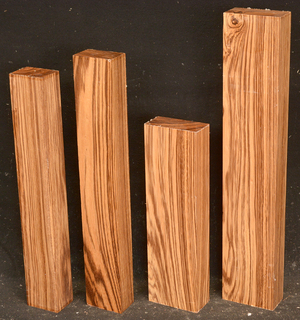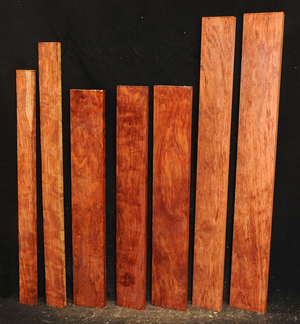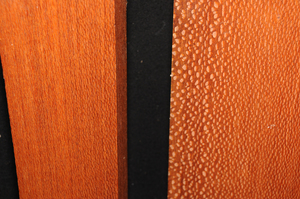Shihuahuaco Turning Squares
Item Number: W43175
Shihuahuaco Turning Squares
Item Number: W43174
Shihuahuaco Turning Squares
Item Number: W43173
Shiwauwauco Bowl Blanks
Item Number: W43172
Zebrawood
Microberlinia brazzavillensis
This striped wood develops a beautiful golden patina as it ages.
Item Number: W43171
Zebrawood
Microberlinia brazzavillensis
This striped wood develops a beautiful golden patina as it ages.
Item Number: W43170
Zebrawood
Microberlinia brazzavillensis
This striped wood develops a beautiful golden patina as it ages.
Item Number: W43169
Mexican Bocote Turning Squares
Cordia elaeagnoides
Bocote is an oily wood with a yellowish to dark brown color accented with irregular black stripes and streaks. It has a spicy smell and is hard, heavy and strong. It is easy to work and takes a very nice polish. This beautiful wood is seldom seen in woodworker's shops.
Item Number: W43165
African Blackwood
Dalbergia melanoxylon
The heartwood is purplish to brownish-black with dark gray streaks giving an overall impression of being black. Lustrous with an attractive inner chatoyance. Very hard, heavy, close-grained, and virtually free from pores. Its stability and lovely tonal qualities make it an excellent instrument wood.
Due to CITES regulations, we can only ship this species to customers in the United States.
Item Number: W43164
African Blackwood
Dalbergia melanoxylon
The heartwood is purplish to brownish-black with dark gray streaks giving an overall impression of being black. Lustrous with an attractive inner chatoyance. Very hard, heavy, close-grained, and virtually free from pores. Its stability and lovely tonal qualities make it an excellent instrument wood.
Due to CITES regulations, we can only ship this species to customers in the United States.
Item Number: W43163
Sitka Spruce
Picea sitchensis
A conifer species native to the Pacific Coast of the U.S.A. It became well known during World War II because of its use in airplane construction. Widely used for sounding boards and tonewoods in the manufacture of musical instruments.
Item Number: W43162
Sitka Spruce
Picea sitchensis
A conifer species native to the Pacific Coast of the U.S.A. It became well known during World War II because of its use in airplane construction. Widely used for sounding boards and tonewoods in the manufacture of musical instruments.
Item Number: W43161
Peroba Rosa Cane Blanks
Aspidosperma sp.
Found throughout tropical America, mainly Brazil. This is a fairly hard and heavy wood with a fine texture. It has a light pastel pink to reddish-orange heartwood. It is easy to work, takes a nice polish, and is stable in service. Not common on the market.
Item Number: W43159
Zebrawood
Microberlinia brazzavillensis
This striped wood develops a beautiful golden patina as it ages.
Item Number: W43158
Zebrawood
Microberlinia brazzavillensis
This striped wood develops a beautiful golden patina as it ages.
Item Number: W43157
Figured Bubinga
Guibourtia tessmannii
Called by some woodworkers African Rosewood, Bubinga is a deep, lustrous, brownish-red color with a fine, darker striping. The figure makes the wood doubly beautiful. It is very hard and heavy and takes a glassy, smooth finish.
Due to CITES regulations, we can only ship this species to customers in the United States.
Item Number: W43156
Camphor Burl
Cinnamomum sp.
This rare burl is from S.E. Asia and is seldom seen on the world market. It is fine-grained and varies in color from a light reddish-brown to almost scarlet. It is easy to work and has a very pungent, spicy scent. For a burl it is remarkably stable. Green to partially air dried.
Item Number: W43153
Camphor Burl Bundle & Blocks
Cinnamomum sp.
This rare burl is from S.E. Asia and is seldom seen on the world market. It is fine-grained and varies in color from a light reddish-brown to almost scarlet. It is easy to work and has a very pungent, spicy scent. For a burl it is remarkably stable. Green to partially air dried.
A has 5 pieces.
Item Number: W43152
Camphor Burl
Cinnamomum sp.
This rare burl is from S.E. Asia and is seldom seen on the world market. It is fine-grained and varies in color from a light reddish-brown to almost scarlet. It is easy to work and has a very pungent, spicy scent. For a burl it is remarkably stable. Green to partially air dried.
Item Number: W43151
Camphor Burl Turning Squares
Cinnamomum sp.
This rare burl is from S.E. Asia and is seldom seen on the world market. It is fine-grained and varies in color from a light reddish-brown to almost scarlet. It is easy to work and has a very pungent, spicy scent. For a burl it is remarkably stable. Green to partially air dried.
Item Number: W43150
Camphor Burl Turning Squares
Cinnamomum sp.
This rare burl is from S.E. Asia and is seldom seen on the world market. It is fine-grained and varies in color from a light reddish-brown to almost scarlet. It is easy to work and has a very pungent, spicy scent. For a burl it is remarkably stable. Green to partially air dried.
Item Number: W43149
Camphor Burl Turning Squares
Cinnamomum sp.
This rare burl is from S.E. Asia and is seldom seen on the world market. It is fine-grained and varies in color from a light reddish-brown to almost scarlet. It is easy to work and has a very pungent, spicy scent. For a burl it is remarkably stable. Green to partially air dried.
Item Number: W43148
Camphor Burl Turning Squares
Cinnamomum sp.
This rare burl is from S.E. Asia and is seldom seen on the world market. It is fine-grained and varies in color from a light reddish-brown to almost scarlet. It is easy to work and has a very pungent, spicy scent. For a burl it is remarkably stable. Green to partially air dried.
Item Number: W43147
Figured African Blackwood Turning Squares
Dalbergia melanoxylon
The heartwood is purplish to brownish-black with dark gray streaks giving an overall impression of being black. Lustrous with an attractive inner chatoyance. Very hard, heavy, close-grained, and virtually free from pores. Its stability and lovely tonal qualities make it an excellent instrument wood.
Due to CITES regulations, we can only ship this species to customers in the United States.
A has cluster burls.
B has burl clusters and swirly grain.
C has burl clusters and swirly grain.
D has bird's-eyes and swirly grain.
E has burl clusters and swirly grain.
F has burl clusters and swirly grain. Has a small void on one face.
Item Number: W43145
Figured African Blackwood Turning Squares
Dalbergia melanoxylon
The heartwood is purplish to brownish-black with dark gray streaks giving an overall impression of being black. Lustrous with an attractive inner chatoyance. Very hard, heavy, close-grained, and virtually free from pores. Its stability and lovely tonal qualities make it an excellent instrument wood.
Due to CITES regulations, we can only ship this species to customers in the United States.
A has burl clusters and swirly grain.
B has burl clusters.
C has burl clusters and swirly grain.
D has burl clusters and swirly grain.
E has burl clusters and swirly grain.
F has bird's-eyes, burl clusters and swirly grain.
Item Number: W43144
English Brown Oak Bowl Blanks
Quercus robur
This Oak grew on the grounds of Woburn Abbey in England. The tree was 6-7 feet in diameter and its age was estimated at 600 years plus. The log yielded almost 4,000 board feet of lumber. I had the Oak quartersawn so as to exhibit the beautiful rays or 'silver grain' inherent to this species. It also has a dark pigment tiger-striping that makes this Oak doubly gorgeous. We have boards 1", 1 1/2", 2", and 3" thick and up to 30" wide. We have just stickered this wood to air dry. These pieces are still green.
The sap is a little punky on these pieces. They also can have little voids common to the species.
Item Number: W43141
Camphor Burl Turning Squares
Cinnamomum sp.
This rare burl is from S.E. Asia and is seldom seen on the world market. It is fine-grained and varies in color from a light reddish-brown to almost scarlet. It is easy to work and has a very pungent, spicy scent. For a burl it is remarkably stable. Green to partially air dried.
Item Number: W43139
Peroba Rosa Turning Squares
Aspidosperma sp.
Found throughout tropical America, mainly Brazil. This is a fairly hard and heavy wood with a fine texture. It has a light pastel pink to reddish-orange heartwood. It is easy to work, takes a nice polish, and is stable in service. Not common on the market.
Item Number: W43136
Peroba Rosa
Aspidosperma sp.
Found throughout tropical America, mainly Brazil. This is a fairly hard and heavy wood with a fine texture. It has a light pastel pink to reddish-orange heartwood. It is easy to work, takes a nice polish, and is stable in service. Not common on the market.
Item Number: W43135
Peroba Rosa
Aspidosperma sp.
Found throughout tropical America, mainly Brazil. This is a fairly hard and heavy wood with a fine texture. It has a light pastel pink to reddish-orange heartwood. It is easy to work, takes a nice polish, and is stable in service. Not common on the market.
Item Number: W43134
Peroba Rosa
Aspidosperma sp.
Found throughout tropical America, mainly Brazil. This is a fairly hard and heavy wood with a fine texture. It has a light pastel pink to reddish-orange heartwood. It is easy to work, takes a nice polish, and is stable in service. Not common on the market.
Item Number: W43133
European Pearwood Turning Squares
Pyrus communis
Almost all Pearwood imported into the U.S.A. has been steamed to bring out a more pinkish-red color and to prevent drying stresses. Formerly the wood was used for carving, turning, drawing instruments, wood engravings, textile printing blocks, and tool handles. Stained black it is an excellent substitute for Ebony. Contemporary uses include woodwinds such as recorders, furniture, kitchen accessories, jewelry and other boxes, and architectural uses such as paneling and doors.
Item Number: W43131
Mexican Bocote Knife Handle Scales
Cordia elaeagnoides
Bocote is an oily wood with a yellowish to dark brown color accented with irregular black stripes and streaks. It has a spicy smell and is hard, heavy and strong. It is easy to work and takes a very nice polish. This beautiful wood is seldom seen in woodworker's shops.
Item Number: W43128
Mexican Bocote Turning Squares
Cordia elaeagnoides
Bocote is an oily wood with a yellowish to dark brown color accented with irregular black stripes and streaks. It has a spicy smell and is hard, heavy and strong. It is easy to work and takes a very nice polish. This beautiful wood is seldom seen in woodworker's shops.
Item Number: W43127
Mexican Bocote Turning Squares
Cordia elaeagnoides
Bocote is an oily wood with a yellowish to dark brown color accented with irregular black stripes and streaks. It has a spicy smell and is hard, heavy and strong. It is easy to work and takes a very nice polish. This beautiful wood is seldom seen in woodworker's shops.
Item Number: W43126
Camphor Burl
Cinnamomum sp.
This rare burl is from S.E. Asia and is seldom seen on the world market. It is fine-grained and varies in color from a light reddish-brown to almost scarlet. It is easy to work and has a very pungent, spicy scent. For a burl it is remarkably stable. Green to partially air dried.
Item Number: W43124
Camphor Burl
Cinnamomum sp.
This rare burl is from S.E. Asia and is seldom seen on the world market. It is fine-grained and varies in color from a light reddish-brown to almost scarlet. It is easy to work and has a very pungent, spicy scent. For a burl it is remarkably stable. Green to partially air dried.
Item Number: W43123
Claro Walnut Bowl Blanks
Juglans hindsii
A tree found in Southern Oregon and Northern California with the best material coming from the San Joaquin Valley. Lighter in color than Eastern Black Walnut (Juglans regia) it is often found with curly and quilted figure. Burly stumps are also a valuable source of wood for veneers, gunstocks, and wood turning blanks.
Item Number: W43120
Figured Claro Walnut Turning Squares
Juglans hindsii
A tree found in Southern Oregon and Northern California with the best material coming from the San Joaquin Valley. Lighter in color than Eastern Black Walnut (Juglans regia) it is often found with curly and quilted figure. Burly stumps are also a valuable source of wood for veneers, gunstocks, and wood turning blanks.
Item Number: W43119
Thuya Burl Bundle & Turning Squares
Tetraclinis articulata
This bundle contains a mix of species, including
Due to CITES regulations, these can only be shipped to addresses in the United States.
A has 4 pieces.
Item Number: W43117
Black Mesquite
Prosopis nigra
A very few pieces of Mesquite are figured with what we call frog's-hair curl, a small, tight curl with as many as 12-15 curls per inch. A very stable wood. Air-dried.
Item Number: W43116
Figured Bubinga
Guibourtia tessmannii
Called by some woodworkers African Rosewood, Bubinga is a deep, lustrous, brownish-red color with a fine, darker striping. The figure makes the wood doubly beautiful. It is very hard and heavy and takes a glassy, smooth finish.
Due to CITES regulations, we can only ship this species to customers in the United States.
Item Number: W43114
Figured Bubinga Cane Blanks
Guibourtia tessmannii
Called by some woodworkers African Rosewood, Bubinga is a deep, lustrous, brownish-red color with a fine, darker striping. The figure makes the wood doubly beautiful. It is very hard and heavy and takes a glassy, smooth finish.
Due to CITES regulations, we can only ship this species to customers in the United States.
Item Number: W43112
Figured Bubinga
Guibourtia tessmannii
Called by some woodworkers African Rosewood, Bubinga is a deep, lustrous, brownish-red color with a fine, darker striping. The figure makes the wood doubly beautiful. It is very hard and heavy and takes a glassy, smooth finish.
Due to CITES regulations, we can only ship this species to customers in the United States.
Item Number: W43111
Curly European Sycamore
Acer pseudoplatanus
This European Maple is native to central Europe and west Asia. It is a tough, white or cream colored, fine-grained timber. It reminds me of vanilla ice cream because it is so even-colored. It works well in any grain direction. It is used for musical instruments, furniture, cabinetry, and because it is non-staining it is used for kitchen utensils, wooden spoons, rolling pins, and cutting boards. The figure is fiddleback on the quartersawn surface and more of a broken curl on the flatsawn surface. Select, quartersawn material is used for violin backs and sides and necks. Dry.
B is quartersawn.
Item Number: W43110
Canarywood
Centrolobium paraense
This Brazilian hardwood is occasionally seen to have the bright, brilliantly hued colors as found in these boards. It has medium density and is easy to work and finish.
Item Number: W43109
Fishtail Oak
Neorites kevedianus
Similar to Brazilian Lacewood but a bit denser with a darker reddish-brown color. Beautiful, lustrous grain with big, silvery medullary rays on the quartersawn face. This species comes from Australia.
Item Number: W43107
Zebrawood
Microberlinia brazzavillensis
This striped wood develops a beautiful golden patina as it ages.
Item Number: W43104
Genuine Mahogany
Swietenia macrophylla
Also called Acajou, Tropical American Mahogany, and Honduras Mahogany. This medium to large tree occurs throughout Central and South America. Related to Cuban Mahogany (Swietenia mahogani) and Pacific Coast Mahogany (Swietenia humilis). It produces one of the classic furniture and cabinetmaking woods. The heartwood varies from a light reddish-brown to a rich, dark red. Generally straight grained and exceptionally stable, it is easy to machine, hand plane, sand and finish. Occasional logs produce several figures, curly, quilted, and the rare plum pudding figure which looks like large drips running down the board. Used in fine furniture and joinery, boat building, and in the guitar industry for acoustic sets and necks.
Due to CITES regulations, we can only ship this species to customers in the United States.
Item Number: W43103
Castello Boxwood
Calycophyllum multiflorum
Castello Boxwood, though not a true Buxus species, still has a very fine texture and a lovely light canary yellow color. This is truly a dream wood to mill.It is an excellent turnery wood, capable of very fine detail. Also very popular for making scale timbers and other parts for model ships. Air-dried.
Item Number: W43101




































































































